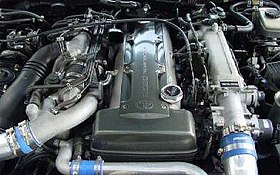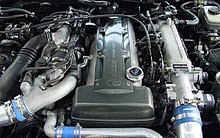
The Toyota Supra is a sports car and grand tourer manufactured by the Toyota Motor Corporation beginning in 1978. The name "supra" is derived from the Latin prefix, meaning "above", "to surpass" or "go beyond".
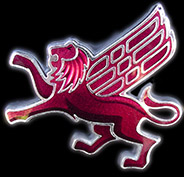
The Toyota Soarer is a personal luxury GT coupé produced from 1981 to 2005 by Toyota and sold in Japan. It was available at both Japanese Toyota dealerships called Toyota Store and Toyopet Store, and it debuted with the Z10 series, replacing the Toyopet Store exclusive Mark II coupé, the Toyota Auto Store exclusive Chaser coupé and the Toyota Store exclusive Crown coupé.

The RB engine is an oversquare 2.0–3.0 L straight-6 four-stroke gasoline engine from Nissan, originally produced from 1985 to 2004. The RB followed the 1983 VG-series V6 engines to offer a full, modern range in both straight or V layouts.

Toyota Motor Corporation's M family of engines were a longitudinally mounted straight-6 engine design. They were used from the 1960s through the 1990s. All M family engines were OHC designs. While the M family was born with a chain-driven single camshaft it evolved into a belt-driven DOHC system after 1980. All M family engines used a cast-iron block with an aluminum cylinder head, and were built at the Toyota Kamigo plant in Toyota City, Japan.

The Toyota Chaser is a mid-size car produced by Toyota in Japan. Most Chasers are four-door sedans and hardtop sedans; a two-door hardtop coupé was available on the first generation only. It was introduced on the 1976 Toyota Corona Mark II platform, and was sold new by Toyota at Toyota Vista Store dealerships only in Japan, together with the Toyota Cresta. The Chaser was produced for six generations, and production ceased in 2001, when it was merged with the Cresta to form the short lived Verossa.

The Toyota AZ engine family is a straight-4 piston engine series. The AZ series uses an aluminium engine block with cast iron cylinder liners and aluminium DOHC cylinder head. The engine series features many advanced technologies including slant-squish combustion chambers, offset cylinder and crank centers, and the VVT-i continuously variable intake valve timing system. The aluminium engine measures 626 mm (24.6 in) long, 608 mm (23.9 in) wide, and 681 mm (26.8 in) tall.

The Toyota UZ engine family is a gasoline fueled 32-valve quad-camshaft V8 piston engine series used in Toyota's luxury offerings and sport utility vehicles. Three variants have been produced: the 1UZ-FE, 2UZ-FE, and 3UZ-FE. Production spanned 24 years, from 1989 to mid 2013, ending with the final production of the 3UZ-FE-powered Toyota Crown Majesta I-FOUR. Toyota's UZ engine family was replaced by the UR engine family.
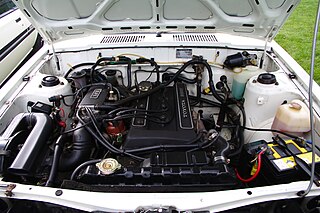
The Toyota T series is a family of inline-4 automobile engines manufactured by Toyota beginning in 1970 and ending in 1985. It started as a pushrod overhead valve (OHV) design and later performance oriented twin cam (DOHC) variants were added to the lineup. Toyota had built its solid reputation on the reliability of these engines.

The Toyota Motor Corporation G-family engine is a family of straight-6 piston engines produced from 1979 to 2008. It is notable in that only a single displacement, 2.0 L (1,988 cc), was produced in this series. Initially belt-driven OHC non-interference engines, multivalve DOHC and variable valve timing were added later during the production run. The 1G-GEU was Toyota's first mass produced four-valve twincam engine. A prototype version of the 1G-GEU called the LASREα–X, featuring twin-turbos, variable valve timing and intake as well as variable displacement, was fitted to the Toyota FX-1 show car at the 1983 Tokyo Motor Show. It showcased a number of technologies which were later to become commonplace.
Toyota Motor Corporation's A family is a family of automatic FWD/RWD/4WD/AWD transmissions built by Aisin-Warner. They share much in common with Volvo's AW7* and Aisin-Warner's 03-71* transmissions, which are found in Suzukis, Mitsubishis, and other Asian vehicles.

The Toyota Mark II is a compact, later mid-size sedan manufactured and marketed in Japan by Toyota between 1968 and 2004. Prior to 1972, the model was marketed as the Toyota Corona Mark II. In some export markets, Toyota marketed the vehicle as the Toyota Cressida between 1976 and 1992 across four generations. Toyota replaced the rear-wheel-drive Cressida in North America with the front-wheel-drive Avalon. Every Mark II and Cressida was manufactured at the Motomachi plant at Toyota, Aichi, Japan from September 1968 to October 1993, and later at Toyota Motor Kyushu's Miyata plant from December 1992 to October 2000, with some models also assembled in Jakarta, Indonesia as the Cressida.
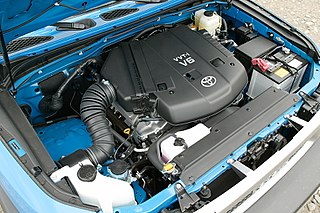
The Toyota GR engine family is a gasoline, open-deck, piston V6 engine series. The GR series has a 60° die-cast aluminium block and aluminium DOHC cylinder heads. This engine series also features 4 valves per cylinder, forged steel connecting rods and crankshaft, one-piece cast camshafts, a timing chain, and a cast aluminium lower intake manifold. Some variants use multi-port fuel injection, some have D4 direct injection, and others have a combination of direct injection and multi-port fuel injection or D4-S.
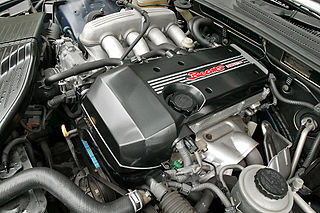
The Toyota S Series engines are a family of straight-four petrol engines with displacements between 1.8 and 2.2 litres, produced by Toyota Motor Corporation from January 1980 to August 2007. The S series has cast iron engine blocks and aluminium cylinder heads.

The Toyota UR engine family is a 32-valve dual overhead camshaft V8 piston engine series which was first introduced in 2006, as the UZ series it replaced began phasing out. Production started with the 1UR-FSE engine with D-4S direct injection for the 2007 Lexus LS. The series launched with a die-cast aluminum engine block, aluminum cylinder heads and magnesium cylinder head covers. All UR engines feature variable valve timing for both intake and exhaust cams or Dual VVT-i. Timing chains are used to drive the camshafts. The UR engine has been produced in 4.6, 5.0, and 5.7-liter displacement versions.

The Toyota Progrès is a mid-size luxury sedan which was sold in Japan from May 1998 to June 2007, replacing the Toyota Corona EXiV. The Progrès included 2.5 L or 3.0 L JZ inline 6-cylinder engines with VVT-i. Since April 2001, the Progrès used 1JZ-FSE and 2JZ-FSE direct injection (D4) engines. The versions with a 1JZ engine were called NC250, and those with a 2JZ engine NC300. It was exclusive to Toyota Japan dealerships Toyopet Store, while its twin the Brevis was exclusive to Toyota Store locations, and shared a marketing approach used on the Toyota Vista Store alternative, called the Toyota Verossa. The width and engine displacement exceed Japanese Government regulations concerning exterior dimensions and engine displacement, and therefore it classified in the larger "passenger car" tax bracket. Two engine sizes were offered to allow Japanese buyers which annual road tax they were willing to pay; the larger engine did offer higher levels of standard equipment and luxury features.
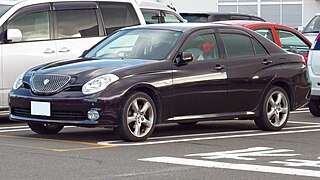
The Toyota Verossa is a mid-size sedan produced by Toyota for the Japanese market, and was exclusive new to the Netz Store locations as the smaller companion sedan to the Aristo. The Verossa exceeded Japanese government dimension regulations concerning external dimensions and engine displacement, offering buyers a sedan that continued to offer a rear-wheel drive platform, opposite the 2001–2006 Camry with very similar dimensions and front-wheel drive platform. The advantage the Verossa offered over the Camry was the ability to offer four-wheel drive, which the Camry couldn't do. The Verossa, introduced in June 2001, was launched with the Toyopet Store alternative called the Progrès and the Toyota Store Brevis.

The Toyota Cresta is a mid-size car built by Toyota. It was launched in 1980 and shared the chassis with the Mark II/Cressida, sold at Toyopet Store dealerships in Japan. The goal of the Cresta was a higher level of luxury in comparison to the Mark II, while the Chaser was the performance-oriented version of the Mark II, but sold at different dealerships. Often available with two-tone paint and more interior convenience options, with the result ending up being more similar to the Cressida sold in export markets. The Cresta was produced for five generations, and production stopped in 2001, when it was merged with the Chaser to form the short lived Verossa.

The AR engine family is an Inline-4 piston engine series by Toyota, first introduced in 2008 for the RAV4, and subsequently for the Highlander, Venza, Camry and Scion tC.

The Toyota Mark II Blit is a mid-size station wagon manufactured by the Japanese automaker Toyota. It is the replacement of the Mark II Qualis and shared a platform with the X110 series Mark II rear-wheel drive sedan, while the Mark II Qualis is a rebadged XV20 series Camry Gracia wagon, with front-wheel drive layout. The Mark II Blit was introduced in January 2002 and ended production in June 2007 due to consolidation efforts. The car remained in production until three years after the Mark X came out, which replaced all of Toyota's X-body sedans, the Verossa, which in turn is a successor to the Chaser and the Cresta, and the Mark II. Toyota's official Mark II Blit successor is the front-wheel drive minivan, the Mark X ZiO, from September 2007. The Mark II Blit marked the return to the Mark II platform with rear-wheel drive layout with optional four-wheel drive and not a wagon version of the front-wheel drive Camry. The car was given a minor facelift in December 2004, including changes to the headlamps, grille and taillamps, which are replaced with LED units. The Mark II Blit uses six-cylinder engines with an optional turbocharger that was discontinued in May 2006, as a result of Japan's emission standards in 2005. The engines used were the 2.0 L 1G-FE, 2.5 L 1JZ-FSE, 2.5 L 1JZ-GE, and 2.5 L single-turbocharged 1JZ-GTE.

The Suzuki K engine family is a series of automobile engines from Suzuki, introduced in 1994. Displacements range from 0.7 L to 1.5 L. All engines have aluminium cylinder blocks with three or four cylinders in-line. Cylinder heads have two overhead camshafts, driven by chain, and four valves per cylinder. Fuel is gasoline/petrol, metered by multipoint fuel injection or direct injection. Some variants are turbocharged.
